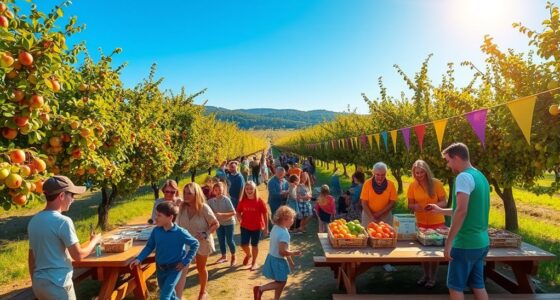On World Gratitude Day, you can honor soil by recognizing its essential role in supporting life, food security, and combating climate change. Protecting soil health through actions like reducing chemical use, planting cover crops, and supporting conservation efforts makes a real difference. By understanding its importance, you contribute to sustainable ecosystems and future resilience. Keep exploring ways you can help protect and preserve this precious resource for generations to come.
Key Takeaways
- Celebrate soil’s vital role in supporting biodiversity, climate health, and ecosystem resilience.
- Promote sustainable farming practices that enhance soil health and prevent degradation.
- Support community initiatives focused on soil conservation and erosion prevention.
- Educate others about soil biodiversity and its importance for food security and environmental stability.
- Take small actions like planting native species and reducing chemical use to protect soil resources.
The Vital Role of Soil in Ecosystem Health
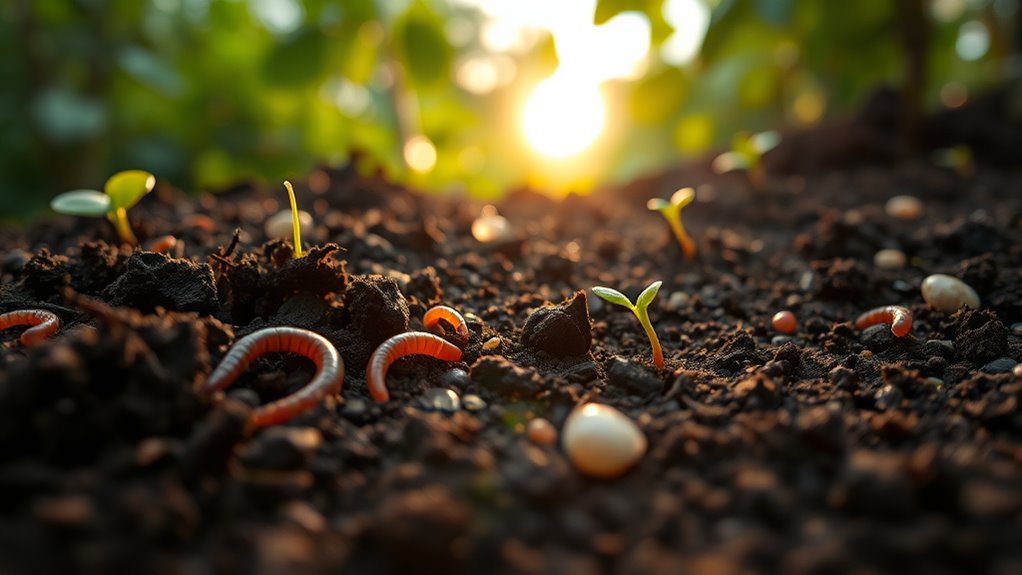
Soil is the foundation of healthy ecosystems, providing essential nutrients and a habitat for countless organisms. Your soil’s biodiversity is essential, supporting a complex web of life that keeps ecosystems resilient. When soil hosts diverse microbes, fungi, and insects, it enhances nutrient cycling, which sustains plant growth and overall health. Additionally, soil plays a pivotal role in soil carbon sequestration, capturing atmospheric carbon and reducing greenhouse gases. This process helps mitigate climate change and maintains ecological balance. By protecting soil biodiversity and promoting carbon storage, you contribute to a healthier planet. Healthy soil ensures clean water, robust plant life, and thriving wildlife, making it an indispensable part of our environment. Recognizing and valuing soil’s role is key to maintaining ecosystem vitality.
How Soil Supports Food Security and Agriculture

Healthy soil is the foundation of productive agriculture and food security. When your soil has high soil fertility, it provides essential nutrients that crops need to grow strong and healthy. This directly boosts crop productivity, ensuring that farmers can produce enough food to meet demand. Good soil management practices, like crop rotation and organic amendments, help maintain this fertility over time. Without healthy soil, yields decline, and food scarcity becomes a real threat. By protecting and nurturing soil health, you support resilient farming systems that can withstand pests, droughts, and other challenges. Ultimately, healthy soil is what sustains the global food supply, nourishing communities and ensuring that everyone has access to nutritious, affordable food.
The Connection Between Soil and Climate Change
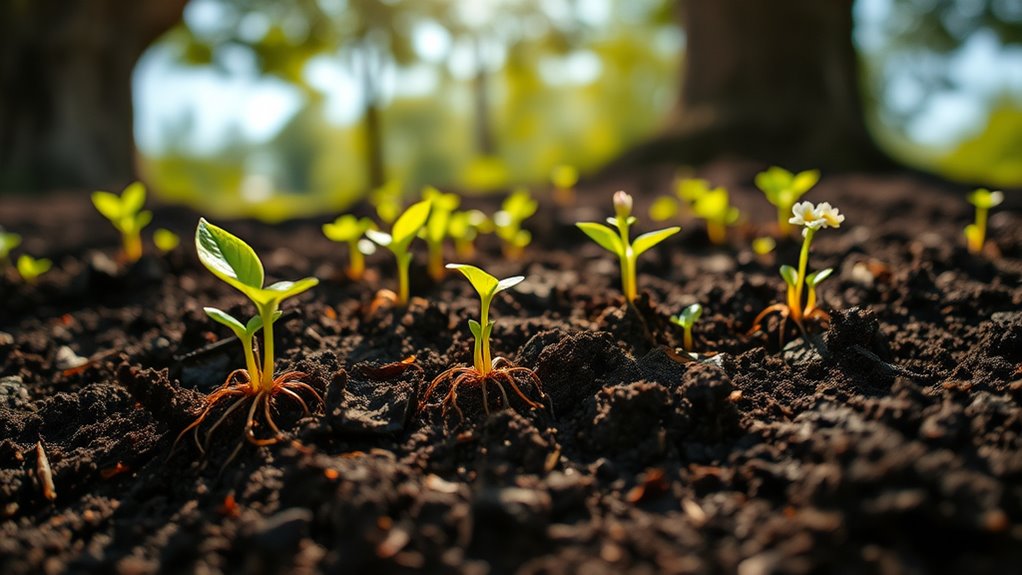
As climate change accelerates, the way you manage soil becomes increasingly crucial in mitigating its effects. Healthy soils act as natural carbon sinks through carbon sequestration, capturing atmospheric CO₂ and reducing greenhouse gases. By practicing soil conservation techniques like cover cropping, reduced tillage, and organic amendments, you help maintain soil structure and enhance its ability to store carbon. Preserving soil health not only supports agricultural productivity but also plays an essential role in lowering overall climate impacts. When you protect soil resources, you contribute to a more stable climate, helping to slow global warming. Soil health is fundamental to maintaining its capacity for carbon storage and ensuring resilient ecosystems. Your efforts in soil management directly influence the planet’s ability to adapt to climate change, making soil conservation essential in our collective response. Engaging in soil preservation practices can further amplify these benefits by promoting biodiversity and ecosystem stability, which is vital for ecosystem resilience in changing climate conditions.
Threats Facing Our Soil Resources
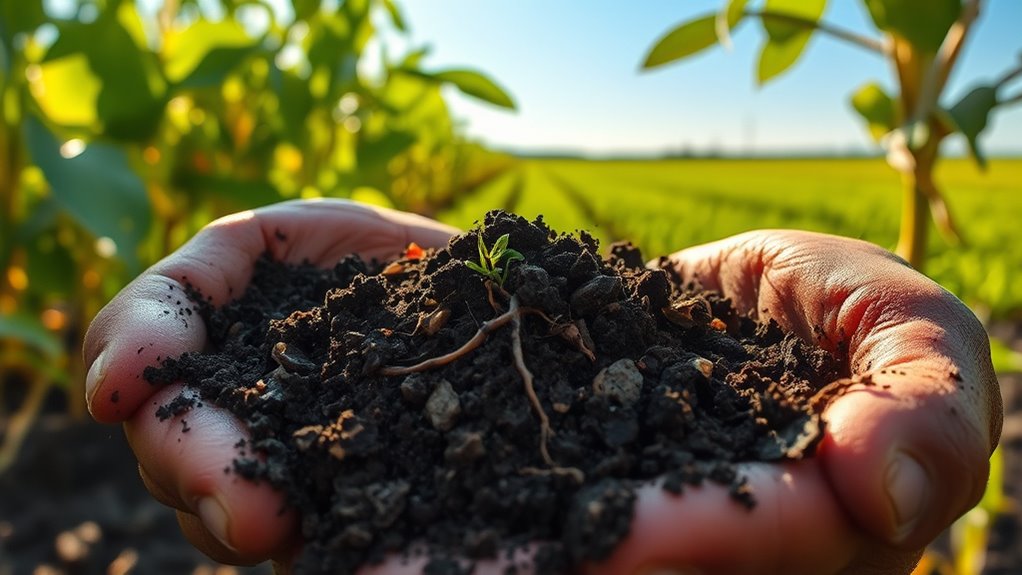
Your soil faces serious threats like erosion and degradation that can reduce its fertility. Pollution and contamination from chemicals and waste further harm the land we rely on. Addressing these issues is vital to protect our soil resources for future generations.
Erosion and Degradation
Erosion and degradation pose serious threats to our soil resources, often occurring when land is left vulnerable to water, wind, or human activities. Without proper soil conservation, essential nutrients wash away, reducing fertility and productivity. Erosion prevention methods like planting cover crops and building terraces protect the soil surface. To understand the risks better, consider this table:
| Cause | Impact |
|---|---|
| Water runoff | Soil loss and reduced fertility |
| Wind erosion | Surface soil removal |
| Deforestation | Increased vulnerability |
| Overgrazing | Soil compaction and erosion |
| Unsustainable farming | Decreased soil quality |
You play a critical role in protecting our soil through mindful practices that prevent erosion and promote healthy, sustainable land. Additionally, implementing soil conservation techniques can significantly mitigate these threats, ensuring the land remains productive for generations to come. Understanding how soil health influences plant growth and ecosystem stability underscores the importance of proactive land management.
Pollution and Contamination
Soil degradation from erosion makes land more vulnerable to pollution and contamination. When soil is already weakened, harmful substances like chemicals, heavy metals, and waste can easily seep in, worsening soil health. To combat this, soil remediation becomes essential; it helps restore contaminated areas and reduces the risk of pollutants spreading further. Pollution mitigation strategies, such as proper waste disposal and reduced chemical use, are crucial in protecting soil quality. You can support this effort by advocating for sustainable farming practices and reducing the use of pesticides and fertilizers. Additionally, implementing Necessary Cookies can help monitor and improve soil conservation programs. Promoting vertical storage solutions and other space-saving methods can also reduce the need for excessive material use, indirectly supporting soil health by minimizing waste. Incorporating advanced remediation techniques can further enhance efforts to clean contaminated soils and restore their natural functions. Employing soil testing methods allows for precise identification of contaminants, enabling targeted cleanup efforts. Utilizing bioremediation techniques, which harness natural biological processes, can significantly accelerate soil detoxification. By actively addressing pollution and contamination, you help preserve soil’s crucial functions, ensuring it continues to nourish plants, support ecosystems, and sustain life for generations to come.
Ways to Protect and Sustain Soil for Future Generations
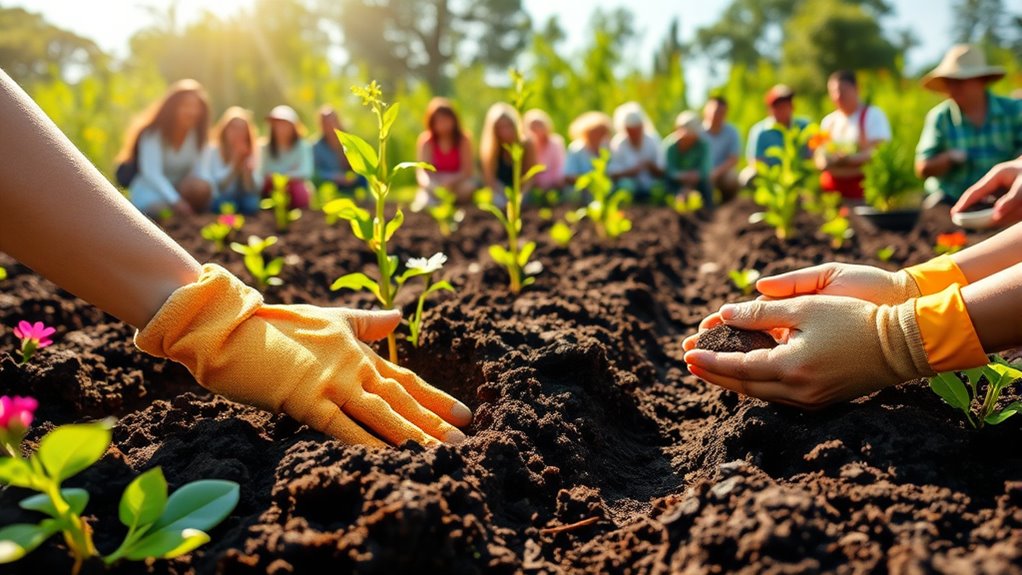
To guarantee soil remains healthy and productive for future generations, taking proactive steps is essential. You can practice soil preservation by minimizing tillage, avoiding chemical overuse, and planting cover crops. These sustainable practices help prevent erosion, maintain nutrients, and boost soil life. Consider implementing crop rotation to reduce pests and improve soil structure. Supporting policies that promote conservation and responsible land management also makes a difference. Engaging in creative practice can foster innovative solutions for sustainable agriculture. Additionally, adopting modern agricultural techniques can further enhance soil health and resilience. Regular monitoring and assessment of soil health using soil testing methods ensure that interventions are effective and tailored to specific needs. Understanding the importance of soil health can inspire more comprehensive conservation efforts.
Celebrating Soil: Actions and Initiatives to Make a Difference
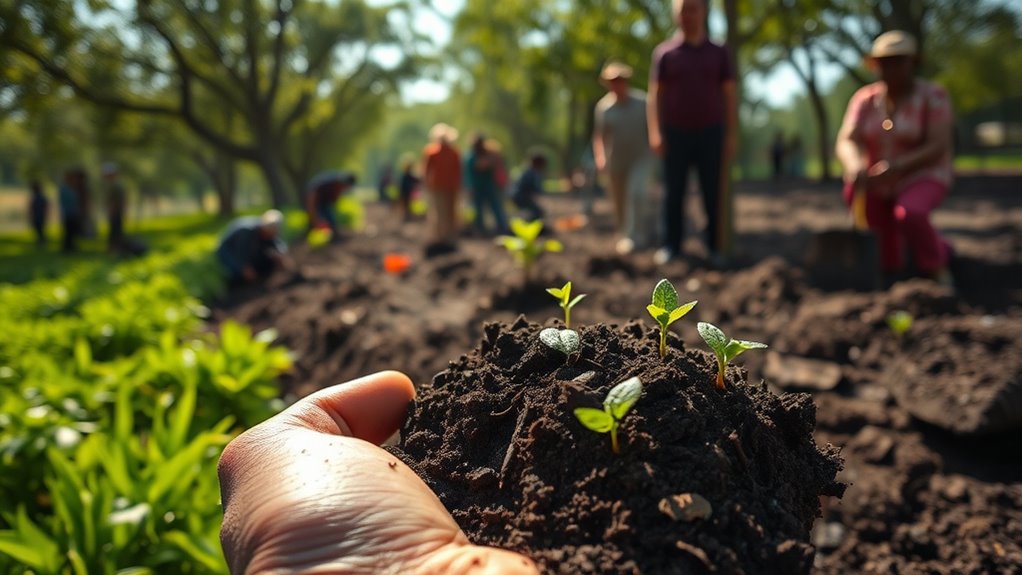
Celebrating soil goes beyond recognizing its essential role; it involves taking concrete actions and supporting initiatives that protect and enhance this precious resource. You can promote soil biodiversity by planting native species and avoiding chemicals that harm beneficial organisms. Supporting community-led projects focused on soil conservation techniques helps prevent erosion and land degradation. Educate others about the importance of maintaining healthy soil ecosystems, emphasizing practices like crop rotation, cover cropping, and reduced tillage. Participating in local conservation efforts or volunteering with organizations dedicated to soil health makes a tangible difference. Understanding soil biodiversity and its significance encourages more mindful stewardship of the land. Incorporating soil health practices into farming and gardening further sustains this vital resource. Learning about soil ecosystem services can inspire more effective conservation strategies. Engaging in soil monitoring and data collection can provide valuable insights into soil condition and guide better management decisions. Additionally, adopting regenerative agriculture techniques can significantly improve soil vitality and resilience. By taking these actions, you contribute to safeguarding soil’s vigor, ensuring it remains fertile and resilient for future generations. Small, consistent efforts create a ripple effect that fosters a healthier planet and a deeper appreciation for soil’s vital role.
Frequently Asked Questions
How Can Individuals Contribute to Soil Conservation Efforts?
You can contribute to soil conservation by practicing soil preservation techniques and supporting sustainable farming practices. Avoid over-tilling, use compost instead of chemical fertilizers, and plant cover crops to protect the soil. Educate others about the importance of healthy soil, reduce your carbon footprint, and support local farmers committed to sustainable methods. Small actions add up, helping to maintain fertile soil for future generations and protect our environment.
What Are the Most Innovative Technologies for Soil Restoration?
You can explore innovative technologies like soil microbiome engineering and regenerative agriculture practices. These methods boost soil health by promoting beneficial microbes that enhance nutrient cycling and plant growth. Using sensors and data analytics, you can monitor soil conditions in real-time, enabling precise interventions. Embracing these advancements helps restore degraded soils, increases biodiversity, and supports sustainable farming, ensuring healthier ecosystems for future generations.
How Does Soil Health Impact Urban Environments and City Planning?
You see, soil health directly influences urban environments and city planning by supporting soil biodiversity, which boosts plant growth and air quality. When you incorporate urban gardening, you’re enhancing green spaces that improve community well-being and reduce heat islands. Healthy soil facilitates sustainable development, encourages biodiversity, and fosters resilient cities. Prioritizing soil health in planning ensures cities remain vibrant, eco-friendly, and better equipped to handle environmental challenges.
Are There Traditional Practices That Effectively Maintain Soil Vitality?
You might consider traditional practices like crop rotation and composting techniques to maintain soil vitality. For example, a small farm uses crop rotation to prevent soil depletion and composting to enrich nutrients naturally. These methods restore soil health, boost productivity, and reduce reliance on chemical fertilizers. Embracing such practices keeps your soil vibrant and sustainable, demonstrating that age-old techniques still offer effective solutions for maintaining soil vitality today.
How Can Education Raise Awareness About Soil Importance Globally?
You can raise awareness about soil importance globally by educating people on soil pollution and sustainable agricultural practices. Share stories, use social media, and organize community workshops to highlight how soil health impacts food security and ecosystems. Encourage governments and farmers to adopt eco-friendly practices, and promote policies that protect soil. By actively engaging communities, you help them understand their role in preserving soil resilience for future generations.
Conclusion
As you celebrate soil on this special day, remember it’s the silent guardian beneath your feet, nurturing life like a gentle heartbeat. By protecting this precious resource, you’re planting seeds for a healthier planet and a vibrant future. Let your actions ripple outward, turning barren fields into lush tapestries of growth. Embrace your role as a steward of the earth, and together, we can guarantee soil’s song continues to echo through generations yet to come.





